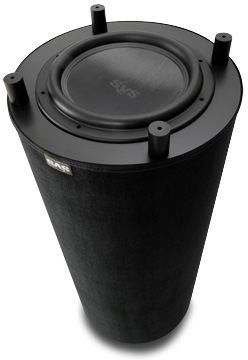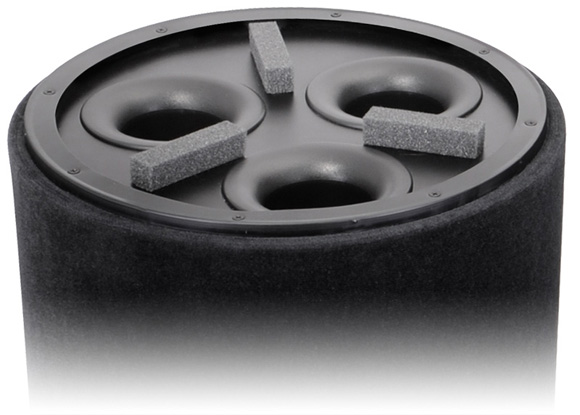 |

DescriptionModel:
PC12-Plus
Price: $949 USD each, $1798/pair
Dimensions: 40"H x 16" diameter
Weight: 60 pounds
Warranty: Three years parts and labor;
45-day money-back guarantee. |

Features
- Downward-firing cylindrical design
- Proprietary 3" flared ports with protective grille
- 525W BASH amplifier (manufacturer rated)
- Selectable 25Hz, 20Hz, 16Hz and sealed modes
- Extra-heavy-duty, detachable 8’ power cord
- 12" woofer
- Black finish
|
I’m a home-theater enthusiast and
equipment reviewer -- a lot of gear passes through my modestly sized home. But since the
day I became involved in the hobby, nothing has grabbed the attention of guests,
neighbors, and assorted workmen as has the PC12-Plus subwoofer from SV Sound
International. Some have said it resembles a garbage can, others that it looks like a
basement water heater. Most just plain don’t know what to make of it. With this
model, SVS literally thought outside the box.
The PC12-Plus is a midsize subwoofer intended to be used in
rooms of small to medium size. It retails factory direct from www.svsound.com and sells for $949. If
one PC12-Plus isn’t enough, $1798 will buy you two. The PC12-Plus replaces not only
SVS’s 25-31PC-Plus subwoofer, which was reviewed
by the SoundStage! Network’s Jeff Fritz in June 2003, but all of the Plus subwoofers
in the company’s powered-cylinder line. Jeff was so impressed with the 25-31PC-Plus
that he gave it a Reviewers’ Choice award. The PC12-Plus had some big shoes to fill.
Features and technology
 The first thing anyone notices about
the PC12-Plus is that it’s a cylinder. According to SVS, this shape renders the
PC12-Plus highly rigid under pressure. The top and bottom of the cabinet are sealed by
Baltic Birch baffles that are a beefy 1.5" thick. The first thing anyone notices about
the PC12-Plus is that it’s a cylinder. According to SVS, this shape renders the
PC12-Plus highly rigid under pressure. The top and bottom of the cabinet are sealed by
Baltic Birch baffles that are a beefy 1.5" thick.
At the bottom of the cabinet is the heart of the PC12-Plus:
its single 12" downward-firing drive-unit with a 3", bifilar-wound voice-coil.
Putting the driver at the bottom makes the PC12-Plus very stable. The 12" cone is
driven by a Bridged Amplifier Switched Hybrid (BASH) "plate" amplifier rated at
525W. SVS says that this amplifier combines class-AB performance with class-D efficiency.
The driver fires directly onto a circular plate attached to the bottom of the cabinet by
three cylindrical standoffs. The plate contacts the floor via small rubber feet, which SVS
calls "compliant disks."
Piercing the PC12-Plus’s top panel are three of
SVS’s Tri-Power High Flow ports. Each port is 3" in diameter, and
precision-molded to mount almost flush with the top panel, with high-density seals. A
15"-diameter grille of black mesh covers the ports, to prevent a child from dropping
his favorite Hot Wheels car down one of them.
The PC12-Plus comes with three foam port plugs, which
operate as tuning devices. Left unplugged, the ports increase the sub’s output --
with all three ports open, the PC12-Plus provides maximum output in most rooms, down to
20Hz. However, the PC12-Plus can be tweaked to dig even deeper. According to SVS, plugging
one port lets the PC12-Plus go down as far as 16Hz. Plugging all three ports fully seals
the cabinet. This configuration, sometimes preferred by music purists, could, in small
rooms, bring the bass response down into single digits, where bass is more felt than
heard. SVS doesn’t recommend plugging two ports because, they say, this can cause the
remaining port to chuff; that is, make the unwanted noises produced when large
volumes of air are forced through a port.

Note, however, that if the port plugs are used to extend
the PC12-Plus’s low-end response, the larger bandwidth the sub is asked to cover will
also reduce its overall output, particularly between 20 and 50Hz, where a lot of bass
content resides in both music recordings and film soundtracks. SVS says that some
customers don’t mind trading a bit of upper-bass response for a deeper reach. But no
matter your personal preference, the sub’s decreased output with all ports plugged
means that that configuration should be used only in small rooms, which tend to have an
inherent "gain" -- a naturally rising response -- at the lowest frequencies.
On the rear panel, in addition to controls for a built-in
parametric equalizer, are settings for gain, subsonic filtering, phase, and crossover
(with a bypass option to route that last function to an A/V processor).
Setup
I connected the PC12-Plus to my Integra DTR-9.9 A/V
processor via a Tesla Resolution Reference active subwoofer cable from Synergistic
Research. Most of my listening was done with SVS’s 18-gauge stock power cord,
although when I compared the PC12-Plus with my MartinLogan Descent i subwoofer, I used my
reference subwoofer power cord, Synergistic Research’s Tesla T3.
Unfortunately, space limitations in my room severely
restrict the placement of any subwoofer. Fortunately for the purposes of this review, I
wasn’t too concerned with appearance; once the PC12-Plus was hooked up, I was able to
experiment a bit with its position. I ultimately concluded that it sounded best when
placed just behind the left front speaker.
At 12’ by 22’, my room is not particularly small.
I therefore began with all three ports unplugged, and set the subsonic filter to 20Hz.
Because I use only one sub, I set the phase to zero. And because the Integra DTR-9.9 has
built-in room-correction software, I disabled the PC12-Plus’s crossover and
parametric equalizer.
I then reran the Integra’s room-correction software
and grabbed Doom (2005), which has a particularly bass-heavy soundtrack. I put my
disc player on Repeat Play and left it running for about 50 hours. If this torture test
doesn’t blow the PC12-Plus to bits, I thought, it’ll surely go a long way
toward breaking it in.
Performance
One of the best discs to test whether a subwoofer can
provide a clean, seamless bottom end is Yim Hok-Man’s Master of Chinese Percussion
(CD, LIM K2HD 033), which was mastered using Winston Ma’s K2HD format. Playing
"Poem of Chinese Drum," the PC12-Plus reproduced so thoroughly with the sounds
of the large Asian drum that it practically became sonically invisible. I noticed the
aural presence of PC12-Plus only when I turned it off. Considering that the rest of my
speakers are electrostatics, which are known to be exceptionally fast in their response to
the signals fed them, this is no small accomplishment.
The PC12-Plus’s pitch definition and leading attack,
two big musts for any convincing reproduction of music, were excellent. Also, while ported
subs can sometimes sound a bit too rich and sumptuous for music reproduction, the
PC12-Plus never sounded bloated. It added punch and weight to this track, but didn’t
overdo things by sounding syrupy, or by shaking and quaking when a more musical
contribution was called for. As for the so-called music purists who believe that a ported
sub can’t make great music, I would say that they likely haven’t heard
the PC12-Plus.
A move away from subtlety and finesse brought me to Paul
Oakenfold’s Tranceport (CD, Kinetic/Reprise 471220-2), that legendary
progressive house standard. The PC12-Plus rendered the bass beat of "Enervate"
with a taut muscularity that would make a club kid smile.
Although I listened to a number of music CDs with all three
ports plugged, I found that leaving them open resulted in the fullest sound. I seldom
listen to recordings of the lowest-reaching instruments (e.g., the pipe organ), so
I saw little need for the depth the sealed mode can provide. In fact, when my system does
go lower than 20Hz, it typically uncovers all kinds of structural problems with my room,
and excites vibrations that aren’t all that easy to damp.
It was time for movies. The PC12-Plus more than met the
task of reproducing the soundtrack of Doom. If you want to know what it sounds like
to rocket at the speed of light toward a (mostly) dead planet that’s being used for
all types of evil genetic experiments, play chapter 1 of Doom with the PC12-Plus in
the system. The SVS excited a huge amount of air during this scene, yet at no time did I
hear any port chuffing -- just deep, crisp bass.
Watching the Blu-ray edition of The Dark Knight, I
was astonished by what the PC12-Plus brought to the table when, in chapter 30, the Joker,
dressed as the scariest-looking nurse I’ve ever seen, blew up Gotham City Hospital.
The PC12-Plus rendered that and every other explosion with impacts that were shockingly
visceral, deep, and clean. Although this soundtrack reaches down to some very deep
frequencies, I unplugged all three of the PC12-Plus’s ports, as this brought the most
slam and impact.
Comparison
As noted above, I compared the PC12-Plus with my
MartinLogan Descent i ($3495), which many consider to be among the top-performing
subwoofers available. The Descent has three 10" aluminum-cone drivers positioned in a
balanced configuration. Each driver is powered by its own 250W amplifier, for a combined
total of 750W. In short, matching the 525W PC12-Plus against the 750W Descent i is the
epitome of unfairness. And for a component such as the PC12-Plus, which swings far above
its league, that’s the way we like it!
In that hospital-demolition scene from The Dark
Knight, the Descent i dipped low and punched hard. A friend thought the MartinLogan
had a bit more headroom than the SVS, but I had difficulty deciding which I preferred. It
turned out that my preference depended on which film I was watching. Both subs went low
enough that my room and I (and, on one occasion, my downstairs neighbor) cried uncle. This
was a major coup for the PC12-Plus.
Only with music-only recordings did the Descent i pull
substantially ahead of the PC12-Plus. Through the MartinLogan, Yim Hok-Man’s
"Poem of Chinese Drum" sounded somewhat cleaner and tauter than through the SVS.
Plugging the PC12-Plus’s ports brought increased articulation, but at the expense of
overall impact and output. Nonetheless, if I had only the SVS to listen to, I could be
very, very happy. And when you factor in the PC12-Plus’s giveaway price -- the
Descent i costs almost four times as much -- the merits of the SVS are utterly compelling.
Conclusion
The SVS PC12-Plus is an extremely versatile subwoofer that
plays both music and film soundtracks in a way that belies its paltry asking price. In
fact, for the ticket price of many similarly performing subs, you could buy two or three
PC12-Pluses: one for each of the two front corners of your home theater, and perhaps a
third, to be placed close to your seating position. That, I think, would be one awesome
setup. You might even have enough cash left over for a Blu-ray player, some videos, and
popcorn. That’s what I call a heck of a good deal. Highly recommended.
| Review
System |
| Speakers - MartinLogan
Vantage (mains), MartinLogan Stage (center), MartinLogan Script i (surrounds), MartinLogan
Descent i (subwoofer) |
| A/V
processor - Integra DTR-9.9 |
| Stereo preamplifier -
NuForce P-9 |
| Amplifier
- Halcro Logic MC50 |
| Sources - Marantz DV9600 DVD
player, Denon DVD-2500BTCI Blu-ray player |
| Power
conditioners - Synergistic Research PowerCell SE, PS Audio Noise Harvesters, DIY
parallel filter |
| Cables and power cords -
Synergistic Research |
| Isolation
devices - Bright Star Audio Big Rocks and Little Rocks, Black Diamond Racing
cones and pucks, DIY amp stands |
| Room treatments -
Synergistic Research Acoustic Art system |
| Display
device - Sony 32XBR6 32" LCD TV |
|
|

